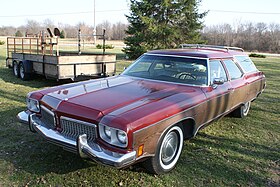Oldsmobile Custom Cruiser
| Oldsmobile Custom Cruiser | |
|---|---|
 |
|
| Overview | |
| Manufacturer | Oldsmobile (General Motors) |
| Production | 1971–1992 |
| Body and chassis | |
| Class | Full-size |
| Body style | 4-door station wagon |
| Layout | FR layout |
| Chronology | |
| Predecessor | Oldsmobile 88 Fiesta |
| First generation | |
|---|---|
 |
|
| Overview | |
| Model years | 1971–1976 |
| Assembly | Lansing, Michigan, United States |
| Designer | Bill Mitchell |
| Body and chassis | |
| Platform | C-body-B-body |
| Related |
Buick Estate Pontiac Grand Safari Pontiac Safari Chevrolet Brookwood Chevrolet Kingswood Chevrolet Townsman |
| Powertrain | |
| Engine | 400 cu in (6.6 L) Pontiac V8 455 cu in (7.5 L) Rocket V8 |
| Transmission | 3-speed TH-400, automatic |
| Dimensions | |
| Wheelbase | 127.0 in (3,226 mm) |
| Length | 1971: 225.3 in (5,723 mm) 1972: 227.0 in (5,766 mm) 1973: 228.3 in (5,799 mm) 1974–75: 231.2 in (5,872 mm) 1976: 231.0 in (5,867 mm) |
| Width | 1971–75: 79.5 in (2,019 mm) 1976: 80.0 in (2,032 mm) |
| Height | 1971–75: 57.2 in (1,453 mm) 1976: 57.1 in (1,450 mm) |
| Curb weight | 5,100–5,400 lb (2,300–2,400 kg) |
| Second generation | |
|---|---|
 |
|
| Overview | |
| Model years | 1977–1990 |
| Body and chassis | |
| Platform | B-body |
| Related |
Buick Electra/LeSabre Estate Buick Estate Pontiac Bonneville Safari Pontiac Catalina Safari Pontiac Parisienne Safari Pontiac Safari Chevrolet Caprice Chevrolet Impala |
| Powertrain | |
| Engine | 307 in³ V8 350 in³ V8 350 in³ diesel V8 403 in³ V8 |
| Transmission | 3-speed Turbo-Hydramatic automatic 4-speed Turbo-Hydramatic automatic |
| Dimensions | |
| Wheelbase | 115.9 in (2,944 mm) |
| Length | 220.3 in (5,596 mm) |
| Width | 79.8 in (2,027 mm) |
| Height | 58.5 in (1,486 mm) |
| Third generation | |
|---|---|
 |
|
| Overview | |
| Model years | 1991–1992 |
| Assembly | Willow Run, Michigan, United States |
| Body and chassis | |
| Platform | B-body |
| Related |
Buick Roadmaster Estate Chevrolet Caprice |
| Powertrain | |
| Engine | 5.0 L L03 V8 5.7 L L05 V8 |
| Transmission | 4-speed 4L60 automatic |
| Dimensions | |
| Wheelbase | 115.9 in (2,944 mm) |
| Length | 217.5 in (5,524 mm) |
| Width | 79.7 in (2,024 mm) |
| Height | 60.3 in (1,532 mm) |
The Oldsmobile Custom Cruiser is a large rear-wheel drive luxury station wagon that was manufactured and marketed by Oldsmobile from 1971 to 1992 across three generations, sharing platforms with the Buick, Pontiac, and Chevrolet full-size wagons. The Custom Cruiser was the first full-size Oldsmobile station wagon since the 1964 Oldsmobile 88 Fiesta station wagon.
Oldsmobile had previously used the Oldsmobile Custom Cruiser name on the Custom Cruiser 90, 96 & 98 models of 1940–1947.
The first generation Custom Cruiser first appeared in 1971 based on the C platform-B platform. With a wheelbase of 127.0 in (3,226 mm) these were the first Oldsmobile station wagons ever to be built on Oldsmobile's largest chassis. The 1971-76 GM full-size bodies, at 64.3" front shoulder room and 63.4" rear shoulder room set a record for interior width that would not be matched by any car until the full-size GM rear-wheel drive models of the early to mid 1990s. The station wagon could seat up to 8 forward-facing people. The Custom Cruiser shared Oldsmobile 98's exterior styling, in particular the 98's distinctive front fascia and rear quarter panels complete with fender skirts. Approximately 80% came with exterior vinyl woodgrained applique. Interior styling took elements from both the Delta 88 and the 98.
The Custom Cruiser wagons, as did other GM full-sized wagons during these years, used a unique rear suspension with multi-leaf springs instead of the coil springs used on other full-sized Oldsmobiles, and other full-sized GM cars. The Custom Cruiser wagons also featured a new clamshell tailgate design where the rear power-operated glass slid up into the roof as the tailgate (manually or with power assist), slid into a recess under the cargo floor. The power tailgate, the first in station wagon history, ultimately supplanted the manual tailgate, which required marked effort to lift from storage. It was operated by switches on the instrument panel or a key switch on the rear quarter panel. The Clamshell system, heavy and complex, made it easier to load and unload the extremely long wagons in tight spaces. But it remained un-adopted by any other manufacturer, and would be eliminated when GM reduced the length of their wagons by about a foot in 1977, and the overriding concern became increased fuel economy.
...
Wikipedia
